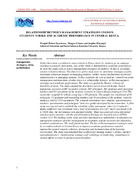| dc.description.abstract | Strikes have been a problem in many schools in Kenya where by students go on rampage resulting to property destruction, loss of life which is detrimental to academic performance. As such this study seeks to assess management strategies on students’ strikes in secondary schools in Central Kenya. The objectives of this study were to: determine strategies used by secondary schools principals in managing students’ strikes, assess the functions of schools’ administrators in managing students’ strikes, establish the role of students’ councils on strike management and determine whether there is a relationship between strikes management strategies and academic performance. The study was guided by Maslow’s theory of hierarchy of needs. The study adopted the descriptive survey research design. Target population consisted of 847 secondary schools, 847 principals, 847 guidance and counseling teachers and 847 presidents of the students’ councils in Central Kenya totaling to 2541.The researcher sampled 85 schools using Gay’s 10% formula. The sample size constituted of 85 principals, 85 guidance and counseling teachers and 85 presidents of the students’ councils making a total of 255 respondents. The research instruments were students’ questionnaires, teachers’ questionnaire and principals’ interview guides developed by the researcher. A pilot study was carried out to establish the reliability of the instruments where by Cronbach’s Alpha coefficient was calculated with a level of acceptance of α ≥ 0.7 and it was found to be α =0.93, thus the instruments were deemed reliable. Data was analyzed using inferential and descriptive statistics with the aid of Statistical Package for Social Sciences (SPSS) version 22.0. The findings of the study provided information to stakeholders in education on appropriate strategies of strike management in secondary schools necessary for improving academic performance. The study found out that: The key strike management strategies used by secondary schools in Central Kenya to improve academic performance entailed approaches geared towards cohesion, interaction and harmonization of the learning environment. The study recommended that to effectively manage student`s strikes, teachers’ and administrators’ should attend seminars and workshops on leadership, commitment to student affairs in order to promote good discipline. | en_US |
